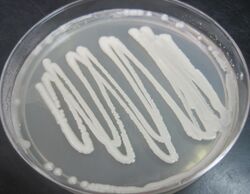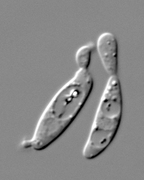Biology:Kriegeriales
| Kriegeriales | |
|---|---|

| |
| Meredithblackwellia eburnea in culture | |
| Scientific classification | |
| Domain: | Eukaryota |
| Kingdom: | Fungi |
| Division: | Basidiomycota |
| Class: | Microbotryomycetes |
| Order: | Kriegeriales Toome & Aime (2013)[1] |
| families | |
The Kriegeriales are an order of fungi in the subdivision Pucciniomycotina. Most species are known only from their yeast states and can be found in a variety of habitats, ranging from arctic waters to tropical ferns. Hyphal states produce auricularioid (laterally septate) basidia.
Taxonomy
The order was described in 2013 based on evidence from DNA sequence data that showed that a newly discovered neotropical yeast, Meredithblackwellia eburnea, was closely related to several species in the genera Kriegeria, Camptobasidium and Glaciozyma.[1] Further research added the new genera Phenoliferia and Yamadamyces to accommodate several yeast species formerly placed in Rhodotorula.[2]
Morphology
Most species of Kriegeriales are asexually reproducing yeasts that do not currently have a known sexual state. All are white or cream, with elongated cells that reproduce by budding at either end. A handful of species have been studied in greater detail and for these it has been shown that the nuclear division of the yeast state occurs in the bud,[1][3] a common character shared with most other basidiomycete yeasts.[4] However, in Meredithblackwellia eburnea, Kriegeria eriophori, and Yamadamyces rosulatus budding cells remain attached to each other at the base, forming characteristic clusters of cells that are otherwise unknown in basidiomycete yeasts.[1][3][5] The species in Glaciozyma differ in that these are yeasts with a known sexual state.[6] Only two members of Kriegeriales, Kriegeria eriophori and Camptobasidium hydrophilum, are known to form hyphae. Of these, K. eriophori also has an asexual yeast state,[3] leaving C. hydrophilum as the only species in the order that is hyphal throughout its life cycle.[7] Ultrastructural studies of these two hyphal species have determined that they have simple septal pores, as is true for all other known Pucciniomycotina.[8]
Habitat and distribution
Species of Kriegeriales can be found in a variety of ecological niches. The members known to date include plant parasites (Kriegeria eriophori), aquatic fungi (Camptobasidium hydrophilum), saprobes, or have unknown roles in nature. Some have been isolated from psychrophilic environments and are associated with glaciers or the Antarctic sea.[6][9] For example Glaciozyma antarctica was one of the first basidiomycete yeasts ever isolated from the Antarctic sea.[10] Others have been isolated from the leaf surfaces of various plants both from temperate and tropical regions; their role in these habitats is unknown.[1][5]
References
- ↑ 1.0 1.1 1.2 1.3 1.4 Toome M, Roberson RW, Aime MC. 2012. Meredithblackwellia eburnea sp. et gen. nov., Kriegeriaceae fam. nov. and Kriegeriales ord. nov. – toward resolving higher-level classification in Microbotryomycetes. Mycologia 105: DOI: 10.3852/12-251
- ↑ "Phylogenetic classification of yeasts and related taxa within Pucciniomycotina". Studies in Mycology 81: 149–189. 2016. doi:10.1016/j.simyco.2015.12.002. PMID 26951631.
- ↑ 3.0 3.1 3.2 McLaughlin DJ, Frieders EM, Berres ME, Doublés JC, Wick SM, 1996. Immunofluorescence analysis of the microtubule cytoskeleton in the yeast phase of the basidiomycetes Kriegeria eriophori and Septobasidium carestianum. Mycologia 88: 339-349.
- ↑ McCully EK, Robinow CF, 1972. Mitosis in heterobasidiomycetous yeasts. I. Leucosporidium scottii (Candida scottii). Journal of Cell Science 10: 857-881.
- ↑ 5.0 5.1 Golubev WI, Scorzetti G, 2010. Rhodotorula rosulata sp. nov., Rhodotorula silvestris sp. nov. and Rhodotorula straminea sp. nov., novel myo-inositol-assimilating yeast species in the Microbotryomycetes. International Journal of Systematic and Evolutionary Microbiology 60: 2501–2506.
- ↑ 6.0 6.1 Turchetti B, Thomas Hall SR, Connell LB, Branda E, Buzzini P, Theelen B, Müller WH, Boekhout T, 2011. Psychrophilic yeasts from Antarctica and European glaciers: description of Glaciozyma gen. nov., Glaciozyma martinii sp. nov. and Glaciozyma watsonii sp. nov. Extremophiles 15: 573–586.
- ↑ Marvanová L, Suberkropp K, 1990. Camptobasidium hydrophilum and its anamorph, Crucella subtilis: a new heterobasidiomycete from streams. Mycologia 82: 208–217.
- ↑ Bauer R, Begerow D, Sampaio JP, Weiss M, Oberwinkler F, 2006. The simple-septate basidiomycetes: a synopsis. Mycological Progress 5: 41–66.
- ↑ Margesin R, Fonteyne PA, Schinner F, Sampaio JP, 2007. Rhodotorula psychrophila sp. nov., Rhodotorula psychrophenolica sp. nov. and Rhodotorula glacialis sp. nov., novel psychrophilic basidiomycetous yeast species isolated from alpine environments. International Journal of Systematic and Evolutionary Microbiology 57: 2179–2184.
- ↑ Fell JW, Statzell AD, Hunter IL, Phaff HJ. 1969. Leucosporidium gen. n., the heterobasidiomycetous stage of several yeasts of the genus Candida. Antonie van Leeuwenhoek 35: 433-462.
Wikidata ☰ Q16984006 entry
 |


